<The original work of BAU DEGS. Cannot be used without referencing BAU DEGS.>
1. Is founded upon the fundamental principles of International maritime law such as the principles of “Equitability”, “Domination of land over sea”, “Proportionality” and “Non-encroachment”. Within the framework of pacta sunt servanda (“agreements must be kept”), is attentive to the continuation of Turkey’s devotion to the offers previously made to other countries.
2. The surrounding seas of Turkey, are either under the enclosed or semi-enclosed sea status. This situation mandates special applications. In the seas with a width less than 400 miles (due to the fact that islands are also located on the continental shelf of the mainlands), the continental shelf of the mainlands are prioritized.
3. Accepts that the seas within the maritime jurisdiction area (Continental shelf and Exclusive Economic Zone),calculated within the framework of aforementioned principles,of the surrounding seas of Turkey and in the Marmara Sea -an inland sea- as the ‘Turkish Maritime Territory’ (Blue Homeland).

4. In the Black Sea, the EEZ declared in 1986 is a part of the Turkish maritime territory.
5. Marmara Sea is an inland sea of Turkey, and without prejudice to any rights implied by the Montreux Convention regarding the regime of the straits, is subjugated to the regime of inland waters.
Within the framework of the provisions set by the Montreux Convention, vessels passing through the straits are expected to be charged according to the current value of ‘‘Gold Franc’.
6. In the Aegean Sea, Turkey’s maritime territory is the area which lies east of the median line, drawn in reliance on the mainlands of Turkey and Greece.
Mandates the determination of the ownership of EGAYDAAK (islands, islets, and rocks whose sovereignty have not been transferred to Greece by Treaties) as an essential condition. Until this matter is clarified, no topic regarding the EEZ’s should be discussed. Viewing EGAYDAAK as the central issue is not a political decision but a necessity by law.
Signals that raising the territorial waters above 6 miles in any region in the Aegean Sea should not be allowed. If it’s possible, for the establishment of peace, stability and safety, it recommends the return of the territorial waters to 3 miles, as foreseen by the Lausanne Treaty.
Expresses that the status of the 23 islands, which were transferred to Greece on the condition that they remain demilitarised, as stated in the 1923 Lausanne Treaty and 1947 Paris Peace Treaty, have been violated by Greece and that this situation extinguishes the condition of transfer of these islands to Greece.
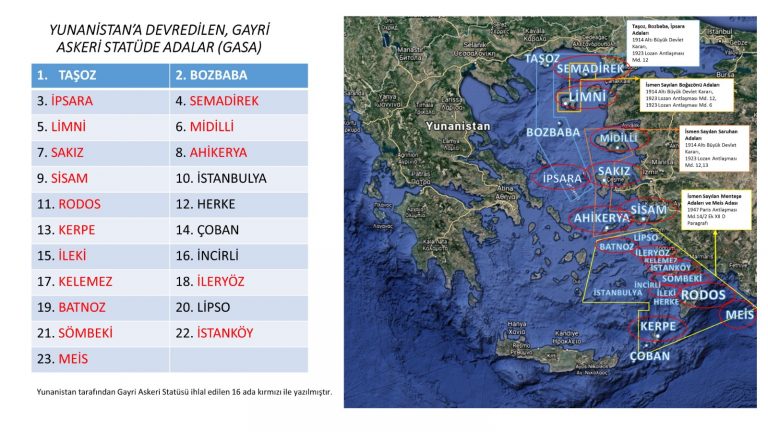
Rejects the unprecedented application of Greece to have an air space of 10 miles over its 6 miles of territorial waters.
States that it is totally incompatible with the international law that Greece put forth its FIR responsibilities as an extension of Greek area of sovereignty and rejects to recognize it as such.
To summarize, states that there are no problems in the Aegean Sea but only demands of Greece and affirms that these demands should never be negotiated. Emphasizes that in the case that these demands are seen as issues, the solution would result in meeting the demands, thus with a compromise from Turkey’s rights and interests.
7. As the country with the longest coast (1870 km) to the Eastern Mediterranean, its maritime jurisdiction should be congruent with such ratio.
Primarily in reliance to Equitability, Proportionality, Non-encroachment and the Domination of land over sea and according to the fundamental rules of international law, affirms in principle that an island’s maritime jurisdiction cannot enter thus divide the opposing coasts situated between the two mainlands.
In delineation of the maritime jurisdiction takes into account factors such as: opposing coasts, point of radiance and origin. In determining the median lines takes into account that the earth is a globe, between Turkey’s southeastern and southwestern latitudes there is a difference of approximately 1.5 degrees and uses diagonal lines.
The respondent states with which Turkey will delineate maritime jurisdictions are Libya, Egypt, Israel (and Philistine), Lebanon and Syria, which is our land-side border only.
This is not an approach that only ensures Turkey’s rights in the Eastern Mediterranean but is an approach that also ensures TRNC, Libya, Egypt, Israel and Lebanon’s rights which stem from international law.
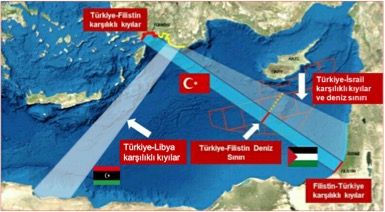
The maritime delimitation agreement made with Libya on November 27th 2019 have designated the western border of our maritime jurisdiction area in the Eastern Mediterranean.
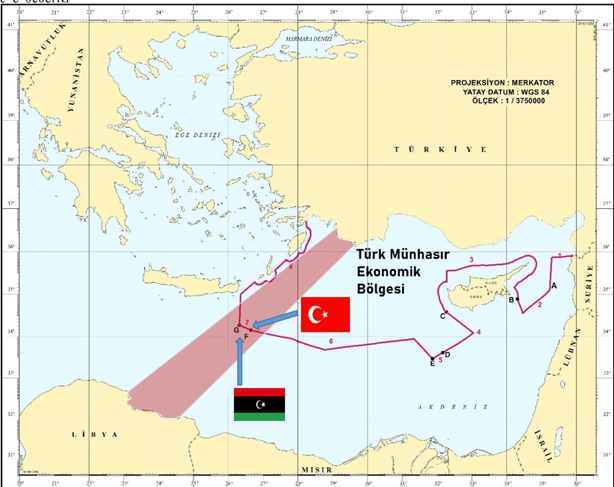
With this line, the maritime area which lies within these borders, assuming an agreement had been made with Egypt on the south, Lebanon and Israel on the east, constitutes the Eastern Mediterranean part of the Turkish maritime territory (Blue Homeland)
The islands of Kara Ada and Fener Ada, adjacent to the island of Meis, are mentioned as some of the islands which were transferred to Italy with the Lausanne Peace Treaty, yet they are not mentioned among the islands which were transferred to Greece with the Paris Peace Treaty. Thus, Kara Ada and Fener Ada’s have not been transferred to Greece. In this case their ownership belongs to the Republic of Turkey, the natural successor of the Ottoman Empire.

8. All applications (search and rescue area of responsibility, environmental emergency intervention area of responsibility, continental shelf, exclusive economic zone, et cetera) of Turkey in its maritime jurisdiction area should be compatible with the map of its maritime territory.
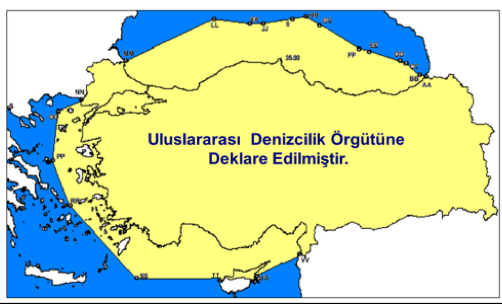
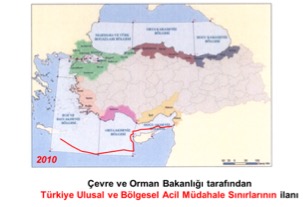
9. Legal arrangements, first and foremost a “legislative of maritime jurisdiction area”, which will meet the entirety of needs, arrange applications and protect the sovereignty rights of the maritime territory of the State of the Republic of Turkey, should be achieved.
Assoc Prof Dr. Cihat Yaycı
TURK DEGS Chairman





















